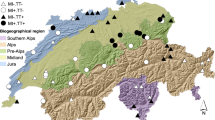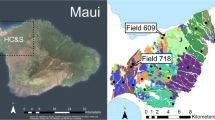Abstract
Soil moisture and temperature are known to be the two environmental constraints regulating mineralization of soil organic carbon (SOC). However, it remains unclear to what extent the moisture, temperature, and other abiotic and biotic factors affect the mineralization of SOC across broad geographic regions. Here, we examined the effects of multiple abiotic and biotic factors on SOC mineralization across 12 widespread arid and semiarid ecosystems on the Mongolia plateau, by using an integrative approach combining short-term laboratory incubations (28-day), field survey, and structure equation modeling (SEM). Our results showed that soil moisture had a predominant control on SOC mineralization across all sites. The average CO2 emissions over all sites increased by 23 % from 30 to 60 % water filled pore space (WFPS) and by 176 % from 60 to 90 % WFPS. Under conditions of 25 °C and 60 % WFPS, the cumulative CO2–C emissions in the topsoil (0–20 cm) diminished in the following order: meadow steppe (227 mg kg−1) > typical steppe (216 mg kg−1) > desert (99 mg kg−1) > desert steppe (72 mg kg−1). The temperature sensitivity of SOC mineralization (Q10), the proportional change in carbon mineralization rate given a 10 °C temperature gradient, was highest under conditions of low temperature and high moisture, but it was lowest under high temperature and low moisture. The SEM analyses demonstrate that the mineralization potential of SOC seems to be directly regulated by microbe activity and substrate availability. Climatic factors (e.g. mean annual precipitation, mean annual temperature), above- and belowground biomass, and soil pH, which regulate SOC and microbial biomass carbon content, also indirectly influence the SOC mineralization. Our results indicate that global climate change, particularly the increase in the frequency of extreme storms and droughts, will substantially affect SOC mineralization and ecosystem carbon cycle in arid and semiarid regions.





Similar content being viewed by others
References
Allison SD, Wallenstein MD, Bradford MA (2010) Soil-carbon response to warming dependent on microbial physiology. Nat Geosci 3:336–340
Alvarez R, Alvarez CR (2000) Soil organic matter pools and their associations with carbon mineralization kinetics. Soil Sci Soc Am J 64:184–189
Alvaro-Fuentes J, Easter M, Paustian K (2012) Climate change effects on organic carbon storage in agricultural soils of northeastern Spain. Agric Ecosyst Environ 155:87–94
Bai YF, Wu JG, Pan QM, Huang JH, Wang QB, Li FS, Buyantuyev A, Han XG (2007) Positive linear relationship between productivity and diversity: evidence from the Eurasian Steppe. J Appl Ecol 44:1023–1034
Bai YF, Wu JG, Xing Q, Pan QM, Huang JH, Yang DL, Han XG (2008) Primary production and rain use efficiency across a precipitation gradient on the Mongolia plateau. Ecology 89:2140–2153
Bai YF, Wu JG, Clark CM, Pan Q, Zhang L, Chen S, Wang Q, Han X (2012) Grazing alters ecosystem functioning and C: n: P stoichiometry of grasslands along a regional precipitation gradient. J Appl Ecol 49:1204–1215
Balogh J, Pinter K, Foti S, Cserhalmi D, Papp M, Nagy Z (2011) Dependence of soil respiration on soil moisture, clay content, soil organic matter, and CO2 uptake in dry grasslands. Soil Biol Biochem 43:1006–1013
Batjes NH (1996) Total carbon and nitrogen in the soils of the world. Eur J Soil Sci 47:151–163
Boone RD, Nadelhoffer KJ, Canary JD, Kaye JP (1998) Roots exert a strong influence on the temperature sensitivity of soil respiration. Nature 396:570–572
Borken W, Matzner E (2009) Reappraisal of drying and wetting effects on C and N mineralization and fluxes in soils. Glob Change Biol 15:808–824
Budge K, Leifeld J, Hiltbrunner E, Fuhrer J (2011) Alpine grassland soils contain large proportion of labile carbon but indicate long turnover times. Biogeosciences 8:1911–1923
Chen DM, Mi J, Chu PF, Cheng J, Zhang L, Pan Q, Xie Y, Bai Y (2014) Patterns and drivers of soil microbial communities along a precipitation gradient on the Mongolian Plateau. Landscape Ecol. doi:10.1007/s10980-014-9996-z
Conant RT, Ryan MG, Agren GI, Birge HE, Davidson EA, Eliasson PE, Evans SE, Frey SD, Giardina CP, Hopkins FM, Hyvönen R, Kirschbaum MUF, Lavallee JM, Leifeld J, Parton WJ, Steinweg JM, Wallenstein MD, Martin Wetterstedt JÅ, Bradford MA (2011) Temperature and soil organic matter decomposition rates: synthesis of current knowledge and a way forward. Glob Change Biol 17:3392–3404
Davidson EA, Janssens IA (2006) Temperature sensitivity of soil carbon decomposition and feedbacks to climate change. Nature 440:165–173
Dioumaeva I, Trumbore S, Schuur EAG, Goulden ML, Litvak M, Hirsch AI (2002) Decomposition of peat from upland boreal forest: temperature dependence and sources of respired carbon. J Geophys Res-Atmos 108: Article Number: 8222
Fierer N, Allen AS, Schimel JP, Holden PA (2003) Controls on microbial CO2 production: a comparison of surface and subsurface soil horizons. Glob Change Biol 9:1322–1332
Garcia-Pausas J, Paterson E (2011) Microbial community abundance and structure are determinants of soil organic matter mineralisation in the presence of labile carbon. Soil Biol Biochem 43:1705–1713
Grace JB (2006) Structural equation modeling and natural systems. Cambridge University Press, Cambridge
Grayston SJ, Vaughan D, Jones D (1997) Rhizosphere carbon flow in trees, in comparison with annual plants: the importance of root exudation and its impact on microbial activity and nutrient availability. Appl Soil Ecol 5:29–56
Gu LH, Post WM, King AW (2004) Fast labile carbon turnover obscures sensitivity of heterotrophic respiration from soil to temperature: a model analysis. Glob Biogeochem Cycles 18:GB1022
Haney RL, Franzluebbers AJ, Porter EB, Hons FM, Zuberer DA (2004) Soil carbon and nitrogen mineralization. Soil Sci Soc Am J 68:489–492
Hartley IP, Ineson P (2008) Substrate quality and the temperature sensitivity of soil organic matter decomposition. Soil Biol Biochem 40:1567–1574
Heimann M, Reichstein M (2008) Terrestrial ecosystem carbon dynamics and climate feedbacks. Nature 451:289–292
Herrmann A, Witter E (2002) Sources of C and N contributing to the flush in mineralization upon freeze-thaw cycles in soils. Soil Biol Biochem 34:1495–1505
Jenkinson DS, Adams DE, Wild A (1991) Model estimates of CO2 emissions from soil in response to global warming. Nature 351:304–306
Joergensen RG (1996) The fumigation–extraction method to estimate soil microbial biomass: calibration of the k EN value. Soil Biol Biochem 28:25–31
Kadono A, Funakawa S, Kosaki T (2008) Factors controlling mineralization of soil organic matter in the Eurasian steppe. Soil Biol Biochem 40:947–955
Kemmitt SJ, Lanyon CV, Waite IS, Wen Q, Addiscott TM, Bird NRA, O’donnell AG, Brookes PC (2008) Mineralization of native soil organic matter is not regulated by the size, activity or composition of the soil microbial biomass: a new perspective. Soil Biol Biochem 40:61–73
Kirschbaum MUF (1995) The temperature dependence of soil organic matter decomposition and the effect of global warming on soil organic C storage. Soil Biol Biochem 27:753–760
Kirschbaum MUF (2004) Soil respiration under prolonged soil warming: are rate reductions caused by acclimation or substrate loss? Glob Change Biol 10:1870–1877
Kirschbaum MUF (2006) The temperature dependence of organic-matter decomposition—still a topic of debate. Soil Biol Biochem 38:2510–2518
Knorr W, Prentice IC, House JI, Holland EA (2005) Long-term sensitivity of soil carbon turnover to warming. Nature 433:298–301
Kucharik CJ, Foley JA, Delire C, Fisher VA, Coe MT, Lenters JD, Young-Molling C, Ramankutty N, Norman JM, Gower ST (2000) Testing the performance of a dynamic global ecosystem model: water balance, carbon balance, and vegetation structure. Glob Biogeochem Cycles 14:795–825
Li XG, Rengel Z, Mapfumo E, Bhupinderpal S (2007) Increase in pH stimulates mineralization of ‘native’ organic carbon and nitrogen in naturally salt-affected sandy soils. Plant Soil 290:269–282
Liu XZ, Wan SQ, Su B, Hui DF, Luo YQ (2002) Response of soil CO2 efflux to water manipulation in a tallgrass prairie ecosystem. Plant Soil 240:213–223
Liu WX, Zhang Z, Wan SQ (2009) Predominant role of water in regulating soil and microbial respiration and their responses to climate change in a semiarid grassland. Glob Change Biol 15:184–195
Matzner E, Borken W (2008) Do freeze-thaw events enhance C and N losses from soils of different ecosystems? A review. Eur J Soil Sci 59:274–284
Norton U, Saetre P, Hooker TD, Stark JM (2012) Vegetation and moisture controls on soil carbon mineralization in semiarid environments. Soil Sci Soc Am J 76:1038–1047
Post WM, Kwon KC (2000) Soil carbon sequestration and land-use change: processes and potential. Glob Change Biol 6:317–327
Raich JW, Schlesinger WH (1992) The global carbon-dioxide flux in soil respiration and its relationship to vegetation and climate. Tellus B 44:81–99
Raich JW, Tufekcioglu A (2000) Vegetation and soil respiration: correlations and controls. Biogeochemistry 48:71–90
Rey A, Petsikos C, Jarvis PG, Grace J (2005) Effect of temperature and moisture on rates of carbon mineralization in a Mediterranean oak forest soil under controlled and field conditions. Eur J Soil Sci 56:589–599
Robertson GP, Coleman DC, Bledsoe CS, Sollins P (eds) (1999) Standard soil methods for long-term ecological research. Oxford University Press, New York
Rousk J, Brookes PC, Bååth E (2009) Contrasting soil pH effects on fungal and bacterial growth suggest functional redundancy in carbon mineralization. Appl Environ Microbiol 75:1589–1596
Rovira P, Vallejo VR (2002) Labile and recalcitrant pools of carbon and nitrogen in organic matter decomposing at different depths in soil: an acid hydrolysis approach. Geoderma 107:109–141
Schmidt MWI, Torn MS, Abiven S, Dittmar T, Guggenberger G, Janssens IA, Kleber M, Kögel-Knabner I, Lehmann J, Manning DA, Nannipieri P, Rasse DP, Weiner S, Trumbore SE (2011) Persistence of soil organic matter as an ecosystem property. Nature 478:49–56
Stemmer M, Gerzabek MH, Kandeler E (1998) Organic matter and enzyme activity in particle-size fractions of soils obtained after low-energy sonication. Soil Biol Biochem 30:9–17
Strickland MS, Lauber C, Fierer N, Bradford MA (2009) Testing the functional significance of microbial community composition. Ecology 90:441–451
Suh S, Lee E, Lee J (2009) Temperature and moisture sensitivities of CO2 efflux from lowland and alpine meadow soils. J Plant Ecol 2:225–231
Suseela V, Conant RT, Wallenstein MD, Dukes JS (2012) Effects of soil moisture on the temperature sensitivity of heterotrophic respiration vary seasonally in an old-field climate change experiment. Glob Change Biol 18:336–348
von Lützow M, Kögel-Knabner I (2009) Temperature sensitivity of soil organic matter decomposition—what do we know? Biol Fertil Soils 46:1–15
Wang CK, Yang JY, Zhang QZ (2006) Soil respiration in six temperate forests in China. Glob Change Biol 12:2103–2114
Wang XW, Li XZ, Hu YM, Lv J, Sun J, Li Z, Wu Z (2010) Effect of temperature and moisture on soil organic carbon mineralization of predominantly permafrost peatland in the Great Hing’an Mountains, Northeastern China. J Environ Sci 22:1057–1066
Wu X, Yao Z, Bruggemann N, Shen ZY, Wolf B, Dannenmann M, Zheng X, Butterbach-Bahl K (2010) Effects of soil moisture and temperature on CO2 and CH4 soil atmosphere exchange of various land use/cover types in a semi-arid grassland in Inner Mongolia, China. Soil Biol Biochem 42:773–787
Zhou XQ, Chen CR, Wang YF, Xu Z, Hu Z, Cui X, Hao Y (2012) Effects of warming and increased precipitation on soil carbon mineralization in an Inner Mongolian grassland after 6 years of treatments. Biol Fertil Soils 48:859–866
Acknowledgments
We are grateful to Tao Sang for comments on an early version of this manuscript. We thank Hongwei Wan and Junhui Cheng for their helps with statistical analysis. We also gratefully acknowledge undergraduate students from the Inner Mongolia Agriculture University for their helps with fieldwork. This project was supported by the Natural Science Foundation of China (31030013, 31320103916), Strategic Priority Research Program of the Chinese Academy of Sciences (XDA05050400), and Land-Cover/Land-Use Program at NASA (Grant No. NNX09AK87G).
Author information
Authors and Affiliations
Corresponding author
Electronic supplementary material
Below is the link to the electronic supplementary material.
Rights and permissions
About this article
Cite this article
Mi, J., Li, J., Chen, D. et al. Predominant control of moisture on soil organic carbon mineralization across a broad range of arid and semiarid ecosystems on the Mongolia plateau. Landscape Ecol 30, 1683–1699 (2015). https://doi.org/10.1007/s10980-014-0040-0
Received:
Accepted:
Published:
Issue Date:
DOI: https://doi.org/10.1007/s10980-014-0040-0




